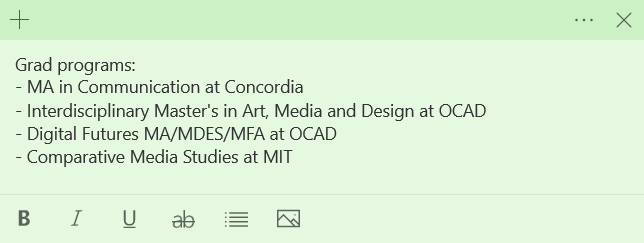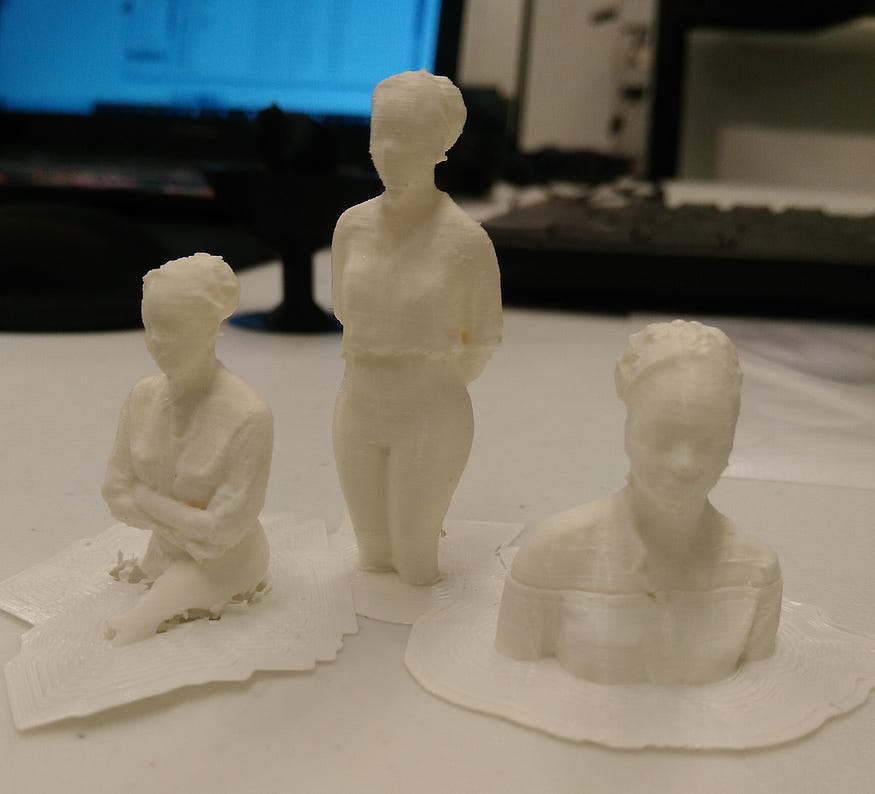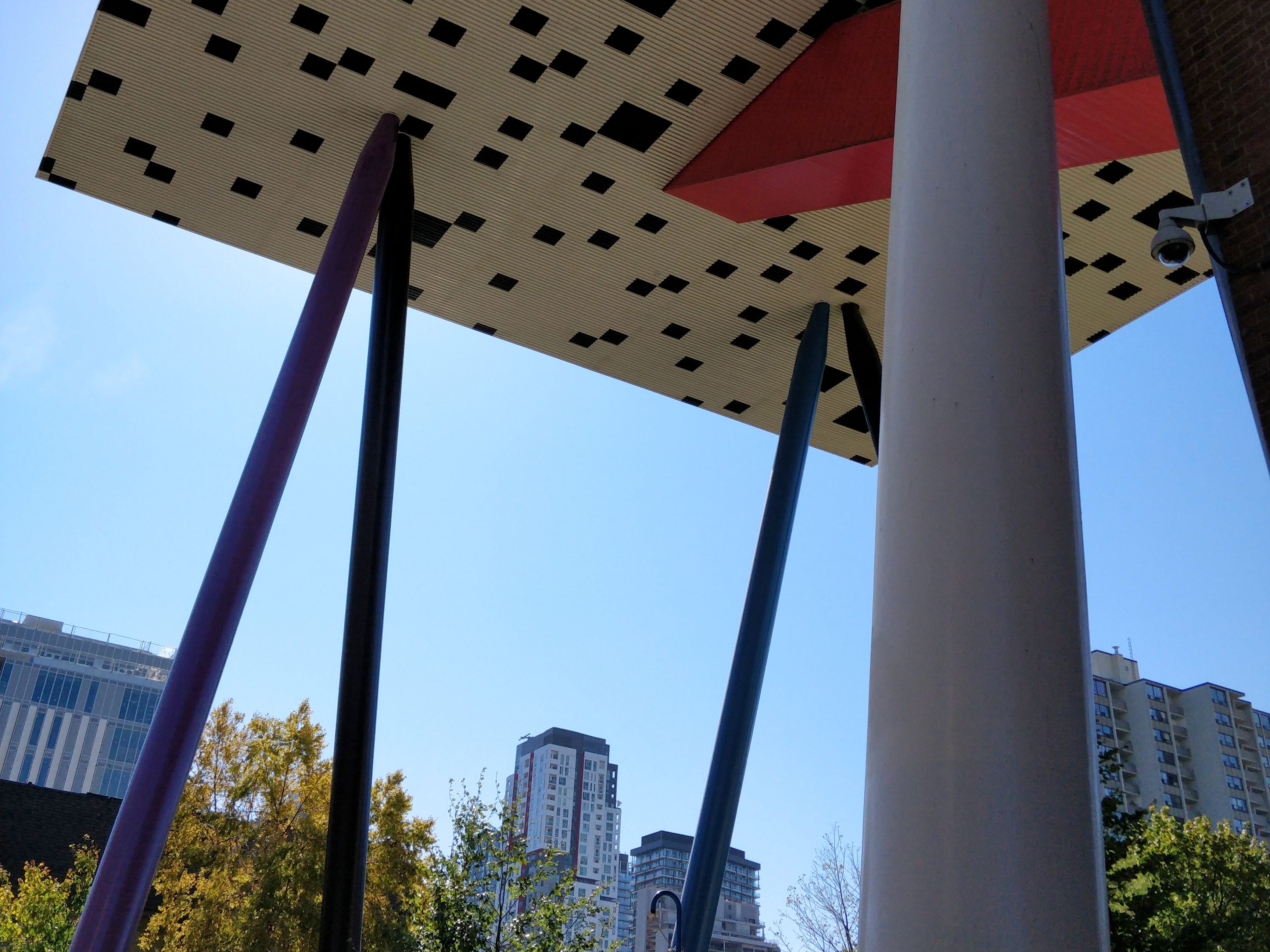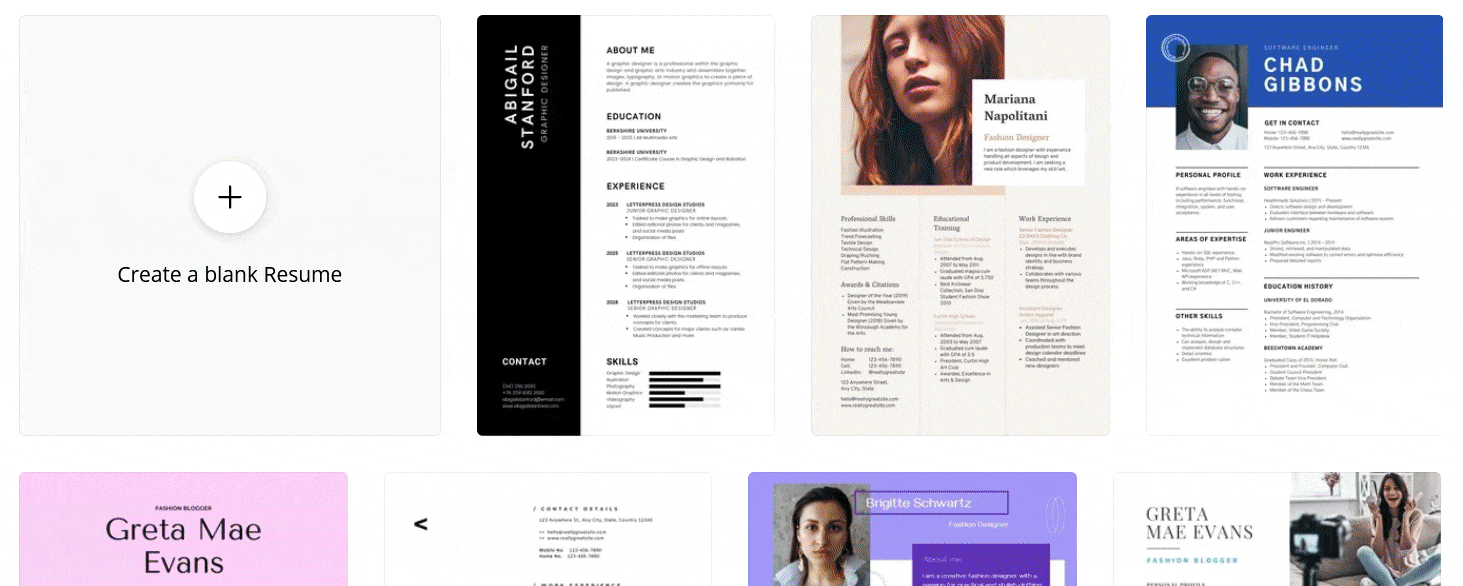My Experience Applying to Grad School at OCAD University: Tips and Tricks (Portfolio Included)

In February of this year, I was admitted to the Master of Arts in Digital Futures at OCAD University, a program I’ve been dreaming about since I first heard about the school on Instagram a few years ago. 🎉🥳
I spent a lot of time (years!) researching different schools and preparing my application, but I had trouble finding any insight online in the form of blogs, articles, or videos from people who were in my shoes. OCAD is, of course, a relatively small university. Still, I know the Digital Futures graduate program is competitive —it’s one of the two graduate programs that isn’t still accepting applications for the incoming Fall term.
My hope for this article is to provide insight and advice on the application process for anyone interested in it.
Who Am I
As you may have seen from my avatar, my name is Candide 💃🏿. I am a digital media enthusiast who recently graduated from uOttawa with an Honours BA in Communication and a minor in Digital Humanities. I’ve spent the last five years taking courses of all kinds, working in various academic, communications, and artistic jobs, volunteering, running student clubs, and somehow finding the time to sleep.
Why Graduate School
I’ll be the first to admit that grad school was the last thing I anticipated doing when I began my Bachelor’s in 2015. As an 18 year old fresh out of high school, I was looking forward to learning more about media theory, but I also started my screenshot collection of “Jobs I Want After I’m Done School.” Despite always being academically-inclined, I saw my undergrad as a formality, something I had to do before starting the career in media and communication I thought I wanted —hence why I signed up for the co-op program.
Fast forward to my 3rd year: I had completed several internships, co-op placements, work-study positions, and FSWEP jobs in my field. I became less and less enchanted with the prospect of working 9 to 5 in a cubicle and scheduling social media posts for the rest of my life. At the same time, I had the privilege of participating in an undergraduate research assistant program and taking classes with older students who dreamed of grad school. Plus, as it turned out, I didn’t hate my required qualitative and quantitative research methods courses as much as I thought I would. In fact, I ended up enrolling in two more in the subsequent years.
So, my decision boiled down to:
- Loving communication theory (and the academic field) but not the jobs ✔️
- Gaining RA experience that I enjoyed ✔️
- Being influenced by peers ✔️
- Liking research methods courses for some reason ✔️
As the years went by, the choice became more and more evident. It even got to the point where I would spend the downtime at my last co-op placement looking up different grad programs. Upon completing the last of my communication courses, I realized that I had a lot more learning and exploration left. I wanted to keep going.
Why OCAD
One day, In my 2nd or 3rd year, I opened Instagram on my phone and saw a post about something called “Gradex.” That was the first time I heard about OCAD University, the largest art, design and media university in the country. I was soon perusing their website to see what other programs they had and took note of the ones that sounded interesting to me on my computer’s sticky notes app:

Sometime after, I participated in a Digital Humanities summer workshop at uOttawa on projection mapping. The workshop was taught by professor Jay from OCAD, who encouraged us to check out their grad programs, and I remembered that faithful sticky note.
As someone who was part of my high school’s visual arts program and worked/volunteered for local arts institutions, I was intrigued by the idea of attending an art school.
I spent about two years researching different graduate programs in communication, digital media, and everything in between. I made use of Airtable’s “Grad School Applications” template to keep track of all the info. I considered Université de Montréal, MIT, York University, Ryerson, Concordia, NYU, etc. As time went on, I developed my research interests further, and my top choices would continuously shift. OCAD, though, always remained on top.

Once I entered my last year of university and approached application time, it was down to OCAD’s MA in Digital Futures, York’s MA in Digital Media, and Université de Montréal’s D.E.S.S. en arts, création et technologies (as a backup). In October of last year, I booked a 6 AM Greyhound bus to Toronto for campus tours at York and OCAD. These tours cemented OCAD as my #1 choice. It sounds silly, but I could instantly imagine myself at the school.

Why Digital Futures
One of the first things I would do when going through the web page of a program of interest would be to look at their curriculum and list of courses. Digital Futures’ was one of the few that truly excited me. Yes, yes, I know it’s vital to ensure that faculty members’ research areas align with my research interests. That said, I was sooooo ready to take classes like “Interactive Documentary” and “Media Lab Prototyping”.
As much as I enjoy communication studies and media theory, I was always looking for something a bit more technologically-inclined, practice-based, and interdisciplinary during my undergrad. My New Media, Video, and Multimedia courses — as much as I enjoyed them — just weren’t enough. Every year, I would attend as many workshops at the school’s Makerspace as I could. When my faculty introduced a new minor in Digital Humanities, I rushed to add it to my degree (despite not knowing what that was) because it had the word “digital” in it. 😅 On top of that, I spent two years as Co-President of the school’s STEM + Arts (STEAM) Club, promoting interdisciplinary collaboration. I figured that if I pursued another degree, it would have to be in something that would satiate my need for creative, tech-y learning.
When looking at the keywords used in the Digital Futures program’s description, ideal student profile, potential careers, course catalogue, previous student theses, and faculty research areas, I felt like they were ticking all the right boxes:
- Digital technology
- Digital fabrication
- Artificial intelligence
- VR & AR
- Transmedia production
- Computation
- Prototyping
- Media arts
- Critical theory
- Etc.
The Application Process
So: I settled on the school. I settled on the program. It was then time for the moment you probably care about the most: applying to Digital Futures at OCAD University. 😬
First things first: I had to ensure that I met the requirements:
- Holding a BA, BFA, BDes, BComm, BSc, BEng or comparable honours degree/certification
- Average of 75 percent (B+) or better during the last two years of study (or relevant experience)
- Creative and conceptual competence at a good level
- Clear potential for acquiring practical knowledge in the diverse disciplines relevant to this graduate program to create an innovative and implementable thesis project
In addition to these requirements, personal info, and declaring whether I wanted to pursue an MA, MDes, or MFA, I had to provide several documents via the application portal. Since I started planning my application two years ahead, I had lots of time to start preparing, collecting, and brainstorming. This was especially crucial since I was still a full-time undergraduate student. Despite my planning, though, I was faced with an application deadline that came a month earlier than previous years (in the middle of exam season!!!), and a requirement from prior years which was replaced.
Here is a detailed breakdown of every additional component for the application:
Research Proposal (800 to 1,000 words)
I started drafting my research proposal the summer before my last year of undergrad using the outline they provided:
- title;
- the idea — what you want to research / do / make;
- the context — your proposed field of study including any relevant theories, methodologies, art or design works, or technologies;
- the rationale for the research — why you want to do this and what is the significance;
- technology, media, or tools that will be used to create the work;
- expected outcome(s) in terms of realized creative work;
- the relevance of the applicant’s background and experience;
- any reference sources used in the proposal;
- bibliography of relevant sources
By then, I had a pretty good sense of the themes and topics I wanted to explore, but tying them together to make sense with the program was a challenge. Once I was able to string together a somewhat coherent draft, my next hurdle was references and bibliography. I had about 2–3 texts from previous courses that informed the context and rationale of my proposal, but I knew that wasn’t enough.
Searching for academic books and journal articles related to my various interests, however, didn’t bring very many relevant results in uOttawa’s library catalogue. That’s when I decided to book an appointment with the school’s Communication and Media Studies librarian. Although the concept was still a jumble in my head, Téa showed me several alternative sources and paths to find references. I came out of that meeting with dozens of engaging texts that I cited in my proposal (or included in the bibliography). The bulk of those citations went into the context and rationale section.
Advice: I noted from the Digital Futures information session that the research proposal showcases the idea for the kind of work you might like to do. They recommend playing to your strengths, explaining what you’d like to develop, what you’ve done to get to this point, and how the program can support your idea. A good starting point is to take a process and augment it through technology.
Since this is a proposal, they aren’t expecting it to be a fleshed-out research project, and you aren’t beholden to that idea once you enter the program. For instance, I had a total of three different titles, eight different research questions in the idea section, and four different expected outcomes. I even listed in the technology / media / tools section the ones I wanted to familiarize myself with and learn. Essentially, you have to strike a balance between openness / flexibility / learning opportunities vs demonstrating that you narrowed in and gave this idea some serious thought.
Portfolio/Samples of Work
This component was the ultimate test in overcoming Imposter Syndrome™
It asked for “samples of relevant student and/or professional work produced in the last five years” that “demonstrate an in-depth understanding of your primary area of interest”.
My primary area of interest is in multimedia production, but as an undergraduate student, my works weren’t the most professional or polished. When I compared it to the works produced by the program’s students (per their portfolio websites), this feeling of inadequacy increased by a ten-fold.
After browsing through the projects I led or participated in over the years, I went with the ones I was the least ashamed / somewhat proud of:
- Five videos produced either alone or as part of a group, including: my Video I exam, a recap video for a workshop my club hosted, a testimonial video I produced for a local non-profit, a vertical video interview I created for work, and a short video produced during a green screen workshop (most can be found here)
- Two graphic designs (a poster and a fillable card with a prompt, both made on Canva 😬)
- A video demo of a prototype for an app I created on Adobe XD for a class on Innovation
- A series of photographs captured for my Film photography exam
- A podcast I edited for my Multimedia I course
- A screenshot of a template I created for Airtable
- A screenshot of a map and interactive graph I produced for my Journalisme numérique II (digital journalism) exam. They show the correlation between school success and income
- A picture of a 3D “selfie” created during a Digital Humanities summer workshop using 3D scanning and 3D printing

Were they my best works at the time? Some, yes.
Did they all reflect my current skill level? Not really.
Did I cringe a little bit when I hit submit? YOU BET.
Mais, c’est la vie. Such is life.
Advice: The portfolio can include “visual work, analysis reports and proposal documents” as well according to OCAD’s graduate admissions page. I also found a portfolio advice page for the undergraduate Digital Futures program. Although it’s not for the graduate program, I felt like it gave me some good insight and inspiration on what to include. This was especially useful as someone who’s never had to create a portfolio for a university application. They also have a general page for undergraduate applicants on portfolio preparation.
CV
This requirement seems pretty straightforward, right? By that point, though, I hadn’t updated my CV in a few years because I was applying to jobs through my school’s co-op program and Work-Study, and they each had their systems for generating resumes. Since OCAD U is an arts and design school, I knew I couldn’t just provide those boring old resumes with uOttawa’s letterhead. On top of this, while perusing the websites of some the students and alumni, I took a peek at their CVs and they were all beautifully designed.
I figured that if I wanted to get into this program, my resume had to look the part.
So I did what I do best: I went to Canva. I know you’re cringing right now: Canva isn’t the ideal choice for typesetting or desktop publishing, but it has a lot of decent design inspiration, and it’s free to use.
I spent a day at my school’s cafeteria cooking up my shiny new resume. I mixed and matched three different templates, moved things around, and hoped for the best. Initially, I wanted to recreate my design idea in a word processor/desktop publishing app but gave up after trying Microsoft Word, LibreOffice Writer, and Scribus.
Advice: Of course, you don’t have to make a fancy resume, but jazzing it up doesn’t hurt. If you’re not the best designer but know how to use Canva, just use Canva. 😅 Some of their templates are pretty nice, in my unprofessional opinion.
Unofficial Transcripts
These were relatively easy to acquire since uOttawa makes it easy to request them online, and they were generated almost instantly.
Program-Specific Questions
The program-specific questions replaced the letter of intent, which was required in previous years. Unfortunately for me, that meant I had drafted a letter over the summer that would no longer be needed.
Instead, I was asked to answer the following questions in the portal:
- How would you describe your work? This can be your creative practice, research, or professional activities.
- What experiences, strengths, or skills will you bring the program from your previous personal, academic, or professional background?
- What digital technologies do you hope to learn about or work with during your time in the program?
- What non-digital topics, materials, or methods do you hope to engage with during your time in the program?
- What are you reading / making / working on right now?
- Please name 2 or more Digital Futures or OCAD U faculty you’d be interested in having as advisors for your thesis project and why.
This section is the time to really highlight why you would be an excellent fit for this program.
Advice: From what I noted from the information session, you want to show that you’ll be successful in the program, excel, and be worth investing in. For question #3, I recommend consulting their course catalogue and noting the skills that are being taught. For question #6, make sure to read through the program’s faculty list and search for each person on Google to learn more about their research areas and latest publications.
Reference Letters
In the application portal, you’ll have to provide the contact information for three people who can provide a letter attesting to your “post-secondary performance, capacity for research and potential for academic study at the graduate level”.
They’ll receive an e-mail to upload their letter directly, and you won’t see the letter (unless they send it to you). Although my application was due on December 13th, my referees had until January 1st.
Advice: I would recommend asking your referees ahead of time, although there is such a thing as too ahead. I remember asking one mine over the summer, and they had forgotten by the time the school year rolled around.
When selecting referees, aim for professors you’ve worked for, have been taught by, collaborated with — or all of the above (even better!). If you ask a potential referrer and they seem hesitant or say that they don’t remember you, I wouldn’t proceed unless you have no other option.
Professors are suuuuuper busy, so a month’s notice is a good rule of thumb. Make sure to provide all the information they need: program name, program description, the reference letter’s guidelines, and how they can submit. Some may even want to see your CV, research proposal, etc., so be ready to provide those.
This might sound obvious, but always thank your referees (after they accept, and after the letter has been submitted), and give them a follow-up about the admission decision.
BONUS: Statement of Intent (OGS)
The graduate application portal also has a separate application form for the Ontario Graduate Scholarship (OGS). If you are eligible for it, I highly recommend applying for this as well. If you started working on your research proposal ahead of time, the bulk of your work is done. You’ll essentially need to compress the proposal down to 3,500 characters (about 580 words).
I was fortunate enough to attend an OGS information session at uOttawa during my undergrad, and we were provided with examples of past statements. For those who would like similar guidance, here is how I structured my OGS Statement of Intent, paragraph by paragraph:
- Title
- Summarized the “rationale” portion of my proposal
- Addressed gaps in the literature and positioned my proposed research within the context of the current knowledge in the field
- Stated what I wanted to research (same as the “idea” section of my proposal)
- Listed my research questions
- Detailed my research and practice objectives (same as the “expected outcome(s)” portion of my proposal)
- Expounded on the theoretical approaches I would use (same as the “context” portion of my proposal)
- Described who I am and identified my preparedness/qualifications to undertake this work
- Works Cited
Advice: Make sure to attend one of OCAD’s information sessions for the external graduate scholarships, or consult the slides (here are the ones for 2019).
⇒ Application Submission and Decision
Final Advice
- Plan a year in advance: I know that life happens and that last-minute decisions are possible, but I highly recommend planning way ahead, especially if you are coming straight out of undergrad as I did. It’ll allow you to start progressively working on your portfolio (if you haven’t already), draft your proposal, and really think about whether this is the right program for you.
- Do thorough research: I’ve mentioned this throughout my article, but take a look at the previous theses (through the Open Research Repository) and projects. Explore the list of faculty and what their research interests and areas of research are. Consult the program guides/curriculum and course catalogue. Read OCAD’s graduate studies brochure. Carefully read the program’s description, ideal student profile, and list of potential careers. Look up what the program’s alumni are doing using LinkedIn and Google. Rinse and repeat every few months. Does it resonate with you? Does it align with your career aspirations? Is it a program you want to spend the next two years of your life completing?
- Take it a step further: Once you’re sold on the program, make sure to sign up for the information session(s) (which typically aren’t recorded). If you’re able to visit Toronto, book a campus tour. Take lots of notes, and ask the right questions. If that’s not possible, they also have a video tour you can check out.
- Start your application as soon as the portal opens: The actual requirements may be different from what is posted on their website, and even from what is listed here. In my case, the portal opened on October 1st 2019.
- Proofreading is key! Make sure to read, re-read, and have someone else read all the texts you’ll be submitting. I wrote my research proposal, answers to the program-specific questions, OGS statement of intent, and portfolio notes in separate Word documents. I then purchased a one-year subscription of Grammarly* to proofread each text thoroughly (although the free version works just fine). One of my referees also provided some feedback on my research proposal.
There you have it!
This article isn’t a foolproof, guaranteed method for getting into the program. Still, I hope this demystifies the application process for those interested in the Digital Futures graduate program at OCAD University. Best of luck!



Comments